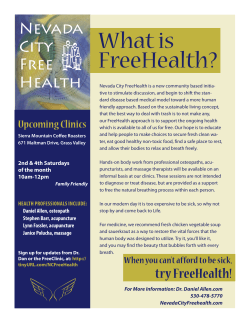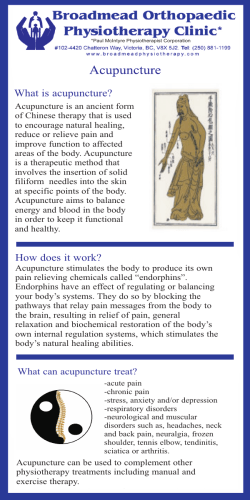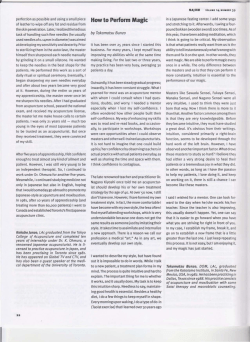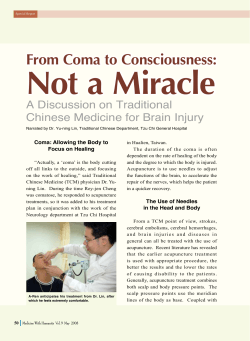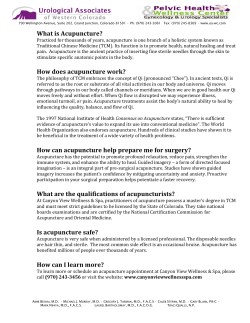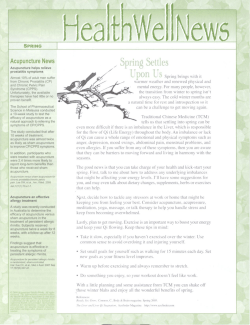
Clinical Sciences
Clinical Sciences Acupuncture Efficacy on Ischemic Stroke Recovery Multicenter Randomized Controlled Trial in China Shihong Zhang, MD, PhD*; Bo Wu, MD, PhD*; Ming Liu, MD, PhD; Ning Li, MD, PhD; Xianrong Zeng, MD, PhD; Hua Liu, MD, PhD; Qingcheng Yang, MD; Zhao Han, MD; Ping Rao, MD; Dong Wang, MD; on behalf of all Investigators Background and Purpose—Acupuncture is a frequently used complementary treatment for ischemic stroke in China but the evidence available from previous randomized trials is inconclusive. The objective of this study was to assess the efficacy and safety of acupuncture in a more robustly designed larger scale trial. Methods—This is a multicenter, single-blinded, randomized controlled trial. Eight hundred sixty-two hospitalized patients with limb paralysis between 3 to 10 days after ischemic stroke onset were allocated acupuncture plus standard care or standard care alone. The acupuncture was applied 5 times per week for 3 to 4 weeks. The primary outcomes were defined as follows: (1) death/disability according to Barthel index and (2) death/institutional care at 6 months. Results—There was a tendency of fewer patients being dead or dependent in acupuncture group (80/385, 20.7%) than in control group (102/396, 25.8%) at 6 months (odds ratio, 0.75; 95% confidence interval, 0.54–1.05). The benefit was noted in subgroup receiving ≥10 sessions of acupuncture (odds ratio, 0.68; 95% confidence interval, 0.47–0.98). There was no statistical difference in death or institutional care between the 2 groups (odds ratio, 1.06; 95% confidence interval, 0.63–1.79). Severe adverse events occurred in 7.6% and 8.3% of patients in the 2 groups, respectively. Conclusions—Acupuncture seemed to be safe in the subacute phase of ischemic stroke. If the potential benefits observed are confirmed in future larger study, the health gain from wider use of the treatment could be substantial. Clinical Trial Registration—URL: http://www.chictr.org/en/. Unique identifier: ChiCTR-TRC-11001353. (Stroke. 2015;46:00-00. DOI: 10.1161/STROKEAHA.114.007659.) Key Words: acupuncture ◼ clinical trial ◼ stroke W orldwide, stroke is the second common cause of death and first leading cause of adult disability.1 In China, there are 1.5 to 2 million new strokes per year and stroke has become the first leading cause of death and disabilty.2,3 The proportion of patients being dependent in daily life is still high at discharge even in those with intensive treatment including rehabilitation.4 In Western medicine, treatment added in standard rehabilitation in the early postacute phase of stroke that might promote the process of recovery such as selective serotonin reuptake inhibitors and constraint-induced movement therapy shows great promise.5,6 Acupuncture which has been used for treating stroke for >1000 years might act in a similar way. Experimental studies have showed its potential beneficial effects in post stroke rehabilitation.7–10 However, randomized controlled trials have yet to show convincing evidence of benefit in acute and subacute ischemic stroke.11–13 In the earlier trials conducted outside China, 2 studies showed that acupuncture can improve motor function and independence in activities of daily living (ADL),14,15 whereas 2 trials using sham treatment as control did not find evidence of benefit.16,17 Although, by contrast, many Chinese trials reported positive results, the conclusions were not regarded as robust, as a result of small sample size and methodological weaknesses as follows: the use of outcome measures that were not internationally recognized; unclear methods of randomization and allocation concealment; the lack of long-term follow-up; and publication bias.12,13,18 Therefore, we designed this randomized controlled trials with a larger sample, and scales to Received October 4, 2014; final revision received March 18, 2015; accepted March 18, 2015. From the Department of Neurology (S.Z., B.W., M.L.) and Department of Acupuncture and Moxibustion (N.L.), West China Hospital, State Key Laboratory of Biotherapy and Cancer Center, Sichuan University, Chengdu, Sichuan Province, China; Department of Neurology (X.Z.), the People’s Hospital of Sichuan province, Chengdu, Sichuan Province, China; Department of Neurology (H.L.), the Second Clinical Medical College of North Sichuan Medical College and Nanchong Central Hospital, Nanchong, China; Department of Neurology (Q.Y.), the People’s Hospital of Anyang City, Anyang, Henan Province, China; Department of Neurology (Z.H.), the first Affiliated Hospital of Wenzhou Medical College, Wenzhou, Zhejiang Province, China; Department of Neurology (P.R.), the First People’s Hospital of Chengdu City, Chengdu, Sichuan Province, China; and the Department of Neurology (D.W.), the Third Affiliated Hospital of Neimenggu Medical College, Baotou, Neimenggu Autonomous Region, China. *Drs Zhang and Wu contributed equally. The online-only Data Supplement is available with this article at http://stroke.ahajournals.org/lookup/suppl/doi:10.1161/STROKEAHA. 114.007659/-/DC1. Correspondence to Ming Liu, MD, PhD, Stroke Clinical Research Unit, Department of Neurology, West China Hospital, State Key Laboratory of Biotherapy and Cancer Center, Sichuan University, 37 Guo Xue Xiang, Chengdu 610041, Sichuan Province, P R China. E-mail wyplmh@hotmail.com © 2015 American Heart Association, Inc. Stroke is available at http://stroke.ahajournals.org DOI: 10.1161/STROKEAHA.114.007659 Downloaded from http://stroke.ahajournals.org/ at1CONS CALIFORNIA DIG LIB on April 16, 2015 2 Stroke May 2015 assess efficacy and safety of acupuncture. The hypothesis was acupuncture, in the immediate postacute phase of ischemic stroke, can improve patients’ independence in ADL over a longer follow-up. Methods Study Design and Participants This study was designed as a multicenter, single-blinded, randomized controlled trial. The study was divided into 2 phases: pilot study from April 2001 to February 2002 and main study from February 2002 to February 2004. The study was registered in Chinese Clinical Trial Register (ChiCTR-TRC-11001353) with protocol approved by the ethics committee of West China Hospital of Sichuan University. Inclusion Criteria Patients aged from 18 to 85 years and both sexes were eligible if they had an acute ischemic stroke and could be enrolled between 3 to 10 days after stroke onset. The ischemic stroke was diagnosed according to the World Health Organization criteria for stroke and all patients had brain computed tomographic or magnetic resonance imaging scan to exclude intracerebral hemorrhage.19 Only patients with limbs paralysis were included. The extent of paralysis had to be such that patients should be unable to walk or eat or dress without assistance. Exclusion Criteria The criteria included the following: (1) dependency in ADL before present stroke, (2) inability to complete scheduled treatment course, (3) infection in acupuncture sites, (4) severe aphasia or unconsciousness making it difficult to comprehend the study or cooperate in evaluation, and (5) other severe complications or comorbidities such as heart/renal function failure. Sample Size The sample size calculation was based on assumption of a ≥10% reduction in the absolute risk of death or dependency in the acupuncture group compared with controls (30%) at 6-month follow-up. Considering possible loss of follow-up (10% to 20%), ≥800 patients (400 patients in each group) were required to test the hypothesis (α=0.05; β=0.80). Randomization and Allocation Concealment The list of treatment allocations were produced centrally by computer-generated random numbers and the randomization sequence was stratified by participating centres. The article revealing the treatment allocation was placed in sequentially numbered, sealed opaque envelopes. After informed consent was obtained, the envelopes were opened sequentially and acupuncture therapists were notified if participants were allocated into acupuncture group. Interventions Patients in both groups received routine ischemic stroke treatment, such as antithrombotic medications and prevention of complications. Rehabilitation was also performed in centres where it was available. Background medical care could differ from center to center but the protocol required all trial patients in a given center to receive the same background care irrespective of treatment allocation. Patients in the treatment group received additional traditional Chinese acupuncture which was started 3 to 10 days after stroke onset, 5 times per week for 3 to 4 weeks (in the pilot study) or 3 weeks (in the main study). Before the trial started, all acupuncturists in participating centres received training of standardized acupuncture procedure. The acupoints with corresponding needling methods used in the present study were selected on the basis of “Xing Nao Kai Qiao” acupuncture methods which was originally developed by the acupuncture research group in the Medical College of Tianjing.20 The main acupoints include Renzhong-DU26, Neiguan-PC6 (both sides), and Sanyinjiao-SP6 (paretic side). Auxiliary acupoints include Baihui-DU20, 4 acupoints on the paretic side (Zusanli-ST36, Fenglong-ST40, Taichong-LK3, and Chize-LL5), and 2 acupoints on the both sides (Fengchi-GB20, Qihai-RN6). The Huato sterile acupuncture needles (1.5–4 cm in length and 0.38–0.42 mm in diameter) were used in the present study. Patients were in the supine position when they were treated. The needling methods for each acupoint have been published in the article of pilot study in the online-only Data Supplement.21 Figure 1. Trial profile. BI indicates Barthel index. Downloaded from http://stroke.ahajournals.org/ at CONS CALIFORNIA DIG LIB on April 16, 2015 Zhang et al Acupuncture in Acute Ischemic Stroke 3 Table 1. Baseline Characteristics of Participants Acupuncture (N=427) Control (N=435) Age, y (mean±SD) 64.1±11.1 64.6±9.9 Sex, men 242 (56.7) 239 (54.9) 355 (83.1) 376 (86.4) 72 (16.9) 59 (13.6) Primary outcomes in this trial were defined as the following: (1) death/disability at 6 months: disability was defined as BI of ≤60 points; (2) death/long-term institutional care at 6 months (in the hospital, nursing home, or rehabilitation house). As sample size/power calculation may vary when it is based on different primary outcomes, sample size calculation based on outcome “death/disability at 6 months” was preset in this study. Secondary outcomes include the following: (1) case fatality; (2) changes of neurological deficit score at the end of scheduled treatment periods or at discharge. Severe adverse events occurred in both groups and adverse events directly related to acupuncture were analyzed to assess acupuncture safety. Statistics Characteristics Hospital West medicine hospital Chinese medicine hospital Past medical history Stroke 71 (16.6) 78 (17.9) 221 (51.8) 244 (56.1) Diabetes mellitus 60 (14.1) 77 (17.7) Hyperlipidemia 36 (8.4) 46 (10.6) Myocardial infarction 11 (2.6) 8 (1.8) Hypertension MRI/computed tomographic scan* Normal 94 (22.0) 92 (21.1) 328 (76.8) 341 (78.4) Left hemisphere 208 (48.7) 213 (49.0) Right hemisphere 195 (45.7) 183 (42.1) Brain stem 6 (1.4) 6 (1.4) Cerebella 0 (0) 1 (0.2) Multiple 15 (3.5) 24 (5.5) Upper limb 410 (96.0) 424 (97.5) Lower limb 414 (97.0) 428 (98.4) Dysphasia 101 (23.7) 105 (24.1) Dysphagia/dysarthria‡ 134 (31.5) 167 (38.7) Facial paralysis 330 (77.3) 347 (79.8) Infarction Lesion sites† Neurological deficits Limb paralysis Ataxia Scandinavian Stroke Scale score (mean±SD) 23 (5.4) 27 (6.2) 32.5±11.2 33.7±15.1 *Computed tomographic scan of 1 patient showed cerebral hemorrhage in acupuncture group. Computed tomographic scan and magnetic resonance imaging (MRI) were not performed in 6 patients. †Lesion site was uncertain in 11 patients. ‡Significant difference between the 2 groups (P=0.037). Evaluations Demographic and clinical characteristics were recorded at the time of enrollment. During treatment period, adverse events which may be related to acupuncture were monitored and reported to the principal investigator who would decide whether acupuncture should be stopped. All patients who did not adhere to the allocated treatment were followed up in full and their data were included into analysis according to intention-to-treat principle. The severity of neurological deficits at baseline and at the end of scheduled treatment periods or at discharge was assessed with Scandinavian Stroke Scale. This scale includes 10 items with total of score ranging from 0 to 60 points (higher points indicate better neurological function). At the end of 3 and 6 months after randomization, patients were followed up by telephone interview. ADL were evaluated by using Barthel Index (BI) which involves 10 personal activities with a maximum of 100 points (higher BI score indicates better function in ADL). The evaluation of both neurological deficits and ADL were performed by investigators who were unaware of treatment allocation. Statistical analyses were performed by using SPSS for Windows statistic software (version 13.0). χ2 test for categorical variables, t test for continuous variables with normal distribution, and nonparametric test for skewed distribution were used to detect difference in baseline characteristics between the 2 groups. For the outcome analysis, odds ratio [OR] with corresponding 95% confidence interval [CI] were calculated for dichotomous data including death, death or disability, and death or long-term institutional care, whereas t test was used to assess difference in changes of neurological deficits score between the 2 groups. The level of significance was set at 5% in the comparison, and all statistical testing was 2-sided. Subgroup analysis was preset to compare patients receiving ≥10 sessions of acupuncture with control group. Results Total of 862 patients from 40 hospitals were enrolled in this study; of them 427 were allocated acupuncture and 435 control (Figure 1). There was no significant difference in baseline characteristics between the 2 groups except more patients with dysphagia and dysarthria in control group than in acupuncture group (Table 1). Two hundred sixty-seven (62.5%) patients in acupuncture group completed all scheduled sessions of acupuncture (≥15 sessions), whereas 54 (12.6%) received 10 to 14 sessions, 59 (13.8%) received 5 to 9 sessions, 24 (5.6%) received 1 to 4 sessions, and 23 (5.4%) did not receive any acupuncture treatment after randomization. The main cause of discontinuing acupuncture was early discharge from hospital (112 patients, 82.4%). The concomitant therapies were comparable between the 2 groups (Table I in the online-only Data Supplement). At 6 months, 40 (9.4%) patients in acupuncture group and 39 (9.0%) patients in control group were lost to follow-up. Fewer patients had died or were dependent in ADL in the acupuncture group (113/410, 27.6%) than in control group (137/405, 33%) at 3 months, the tendency continued at 6 months (80/385 [20.7%] versus 102/396 [25.8%]), but the difference was not statistically significant (OR, 0.75; 95% CI, 0.54–1.05; Table 2). There was also no significant difference in death or institutional care between the 2 groups at 6 months (8.0% versus 7.6%; OR, 1.06; 95% CI, 0.63–1.79). The results above did not change significantly when last observation carried forward analysis was conducted. Post hoc ordinal analysis was performed to assess if there was favorable shift in distribution of scores on BI with acupuncture treatment, and a nonsignificant trend was tested (pooled OR for shift to higher BI, 1.15; 95% CI, 0.88–1.50; P=0.296; Figure 2). Preplanned subgroup analysis showed that only when patients who received ≥10 sessions of acupuncture were included into analysis, a significant difference Downloaded from http://stroke.ahajournals.org/ at CONS CALIFORNIA DIG LIB on April 16, 2015 4 Stroke May 2015 Table 2. Primary and Secondary Outcomes at 3 and 6 Months Acupuncture Control Odds Ratio (N=387) (N=396) (95% Confidence Interval) Outcomes Death or dependency At 3 months* 113 (27.6) 137 (33.0) 0.77 (0.57–1.04) At 6 months 80 (20.7) 102 (25.8) 0.75 (0.54–1.05) At 3 months 38 (8.5) 41 (9.9) 0.93 (0.59–1.48) At 6 months 31 (8.0) 30 (7.6) 1.06 (0.63–1.79) At 3 months 16 (3.9) 16 (3.9) 1.01 (0.50–2.05) At 6 months 24 (6.2) 18 (4.5) 1.39 (0.74–2.60) Death or institutional care† Death *Data of 410 patients in acupuncture group and 405 patients in control group were available at 3 months. †Institutional care indicates that patients are cared in hospital, nursing home, or rehabilitation unit. was detected in death or dependency at 6 months (57/298 [19.1%] versus 102/396 [25.8%]; OR, 0.68; 95% CI, 0.47–0.98; number needed to treat 15) but not for other outcomes (Table II in the online-only Data Supplement). Death occurred in 6.2% and 4.5% of patients in the 2 groups at 6 months, respectively (OR, 1.39%; 95% CI, 0.74–2.60). At the end of the scheduled treatment period, there was significantly greater change of Scandinavian Stroke Scale score from baseline in acupuncture group (9.70±7.85) than in control group (7.57±12.58; P=0.03), which indicated that patients in acupuncture group had greater reduction in their neurological deficit. Severe adverse events occurred in 7.6% of patients in acupuncture group and 8.3% in control group. The most common adverse event directly related to acupuncture is pain, moderate or severe pain occurred in ≈9.4% patients; 1.9% of patients discontinued acupuncture because of severe pain (Table 3). Discussion In this study, we assessed efficacies and safety of acupuncture used in subacute stage of stroke; acupuncture seemed to be a safe treatment but did not show definitive benefits of reducing death or dependency in ADL, although a trend of better outcomes was observed in acupuncture group at 3 and 6 months. Also, acupuncture did not prove to be efficacious in reducing death or long-term institutional care. However, it was noted that there was more improvement of neurological deficits in whole acupuncture group and significant reduction of death or dependency in subgroup receiving ≥10 sessions of acupuncture (OR, 0.68; 95% CI, 0.47–0.98). The effect of acupuncture on death or disability observed in this study is consistent with 3 recently published studies with long-term follow-up and 2 systematic reviews of acupuncture in post stroke rehabilitation.13,22–25 The recent systematic review included 56 randomized trials published before 2009; of the evaluated, 46 used acupuncture within 1-month post stroke and only 10 took functional outcomes; pooled OR of 38 trials was in favor of acupuncture (OR, 4.33; 95% CI, 3.09–6.08).25 Of the 56 included trials, 32 trials were published after 2004, most of them (27 trials) were conducted in China. None of the trials conducted outside China reported positive results on primary outcome, whereas all Chinese trials except 1 showed positive results in favor of acupuncture. In the Cochrane systematic review focusing on efficacy of acupuncture in acute and subacute phases of stroke, metaanalysis of 4 trials with a total of 373 patients showed that there was a borderline significant trend toward fewer patients being dead or dependent (OR, 0.66; 95% CI, 0.43–0.99) in acupuncture group than in control group.13 The meta-analysis showed more aspiring result when data of this study was merged (OR, 0.72; 95% CI, 0.55–0.93; Figure 3). It is suggested that acupuncture might be efficacious in reducing disability but whether the effect is any moderate or less, sample size of this trial is still under power to detect it. In fact, except recombinant tissue-type plasminogen activator thrombolysis within 3 hours after stroke onset, there are few interventions in acute/subacute stage of stroke which showed ≥10% of absolute risk reduction of death or dependency. To clarify this issue, a larger randomized controlled trial with sample size of >1340, according to the result of updated meta-analysis, is needed. If the potential benefits above are confirmed, the health gain from wider use of the acupuncture after stroke could be substantial.26 This study has strengths. First, it is the largest randomized controlled trial of acupuncture for stroke at the moment. Table 3. Adverse Events During Scheduled Acupuncture Treatment Periods Adverse Events Acupuncture (N=427) Control (N=435) P Value Adverse event directly related to acupuncture Faint 2 (0.5) … Dizziness 1 (0.2) … 38 (9.4) … Pain (moderate or severe) Severe adverse event Recurrent stroke Figure 2. Distribution of Barthel index (BI) scores and death at 6 months. BI ranges from 0 (bedridden, incontinent, and requiring constant nursing care and attention) to 100 (no symptoms or disability). The ordinal analysis shows there was nonsignificant increase in the likelihood of better functional outcome in acupuncture group (pooled odds ratio for shift to higher BI, 1.15; 95% confidence interval, 0.88–1.50; P=0.296). Pneumonia and urinary tract infection Others* 7 (1.6) 7 (1.6) 0.97 21 (4.9) 28 (6.4) 0.34 5 (1.1) 4 (0.9) 0.72 *Other severe adverse events include alimentary tract hemorrhage (2 cases), myocardial infarction (1 case), heart failure (1 case), head traumatic (1 case), coma caused by high blood sugar (1 case), drug allergy (1 case), and newly diagnosed cancers (2 cases). Downloaded from http://stroke.ahajournals.org/ at CONS CALIFORNIA DIG LIB on April 16, 2015 Zhang et al Acupuncture in Acute Ischemic Stroke 5 Figure 3. Meta-analysis of randomized trials of acupuncture for acute/subacute stroke. #Trials were included in previous Cochrane systematic review of acupuncture for acute stroke.13 There were 29% reduction of disability or death in acupuncture group compared with control group; the difference is significant (P=0.01). CI indicates confidence interval; and OR, odds ratio. Second, when compared with most published Chinese acupuncture trials, this study was a real randomized trial with adequate allocation concealment, long-term follow-up and blinding assessment. Third, we used disability in ADL or death as primary outcome which have been preferred in trial of acute stroke but just adopted in a few previous trials of acupuncture for stroke. We also evaluated the efficacy of acupuncture on death or long-term institutional care. The use of coprimary outcomes may increase the chance of positive results in favor of the evaluated treatment. Therefore, adjustment of P value for significance (eg, P<0.025 rather than 0.05) should be considered. In this trial, the adjustment of P value for significance has no real impact on the trial’s conclusion because the P values calculated for the 2 primary outcomes were >0.05. Finally, “Xing Nao Kai Qiao” needling method used in this trial is one of the most commonly used acupuncture program in China. Before this trial began, an uncontrolled observational study of 2336 patients with stroke suggested that it was potentially efficacious in improving neurological deficits.27 Thus, we actually assessed efficacy of acupuncture program which is widely accepted and most likely proved to be efficacious. There were 3 limitations in this study. The first limitation is poor compliance of patients with allocated treatment, only 62.5% of patients in acupuncture group received all scheduled sessions of acupuncture, and 6% of patients in control group withdrew and required acupuncture treatment after randomization. The reason for this may be related to the Chinese culture background: most Chinese patients think that acupuncture is useful in improving neurological deficits, so they would request for the therapy if they did not have satisfactory recovery from routine treatment. The second limitation is a little high proportion of loss of follow-up (9.4% in acupuncture group and 9.0% control group). The 2 limitations above made the results more uncertain although sensitivity analysis excluding patient who crossed over to the other group, and analysis by last observation carried forward did not show significant change in the results on primary outcomes. Considering the result of subgroup analysis and main cause of discontinuing acupuncture (early discharge from hospital), 2 weeks for acupuncture treatment period may be an appropriate choice in future trials, especially in China. The third limitation is that reasons for noninclusion of screened patients were recorded only in a proportion of participating centers, which made it difficult to assess generalizability of the trial’s results. However, data from center with the largest number of recruited patients (West China Hospital of Sichuan University) indicated that ≈45% of screened patients were excluded for ineligibility and 40% were not included because of unavailable informed consent. Although sham acupuncture used is the main controversy in design of acupuncture trial, it seems to be reasonable to use sham acupuncture as control to evaluate real or specific effect of acupuncture. However, sham acupunctures which have been used in some previous studies are not feasible in China because patients are well acquainted with acupuncture and recognize the special sensation of “Teh Chi.” Furthermore, sham acupuncture may not be truly inert and may have underlying physiological effects, and hence may not be a proper control group.28,29 To enable us to design a large pragmatic trial, we decided not to use sham acupuncture as control in this study. In contrast to previous Chinese trial in stroke, we used binary outcome as primary outcome (dependency or independency according to BI score) because the systematic review suggested that placebos had no significant effects on objective or binary outcomes in clinical trials.30 In conclusion, this study assessed efficacy of acupuncture used as adjunct to standard care in the early stage of stroke, the result does not support its use in the routine clinical practice from Western medicine perspective. However, a trend toward fewer patients with dependency in acupuncture group was noted, especially in those receiving >10 sessions of acupuncture. Trials with larger scale are needed to confirm the potential benefit of acupuncture for post stroke rehabilitation in future. Downloaded from http://stroke.ahajournals.org/ at CONS CALIFORNIA DIG LIB on April 16, 2015 6 Stroke May 2015 Acknowledgments We would like to thank all doctors and patients who participated in this study for their cooperation. We also would like to express our gratitude to Professor Peter Sandercock of Western General Hospital, Edinburgh, United Kingdom, and Professor KS Wong of Prince of Wales Hospital, Hongkong for useful comments on the article of this study. Sources of Funding This study was funded by the State Administration of Traditional Chinese Medicine of the People’s Republic China. Disclosures None. References 1.Strong K, Mathers C, Bonita R. Preventing stroke: saving lives around the world. Lancet Neurol. 2007;6:182–187. doi: 10.1016/ S1474-4422(07)70031-5. 2. Liu M, Wu B, Wang WZ, Lee LM, Zhang SH, Kong LZ. Stroke in China: epidemiology, prevention, and management strategies. Lancet Neurol. 2007;6:456–464. doi: 10.1016/S1474-4422(07)70004-2. 3. Chen Z. The mortality and death cause of national sample areas. In: Chen Z, ed. The Third National Survey on the Cause of Death. 1st ed. Beijing: Peking Union Medical University Press; 2008:14–15. 4. Sze KH, Wong E, Or KH, Lum CM, Woo J. Factors predicting stroke disability at discharge: a study of 793 Chinese. Arch Phys Med Rehabil. 2000;81:876–880. 5. Mead GE, Hsieh CF, Lee R, Kutlubaev MA, Claxton A, Hankey GJ, et al. Selective serotonin reuptake inhibitors (SSRIs) for stroke recovery. Cochrane Database Syst Rev. 2012;11:CD009286. 6. Sirtori V, Corbetta D, Moja L, Gatti R. Constraint-induced movement therapy for upper extremities in stroke patients. Cochrane Database Syst Rev. 2009;4:CD004433. 7. Wang F, Jia SW. Effect of acupuncture on regional cerebral blood flow and cerebral functional activity evaluated with single-photon emission computed tomography. Zhongguo Zhong Xi Yi Jie He Za Zhi. 1996;16:340–343. 8. Jia HK, Zhang MJ, Guo YL. Impact of acupuncture on plasmaβ-endogenous opioid peptide in patients with stroke. Liaolin J Tradit Chin Med. 1995;22:177. 9. Zhao YL, Zhao JW, Wang H. Sequential acupuncture method for treatment of apoplexy hemiplegia and its effects on plasma ET-1 and NO levels. Zhongguo Zhen Jiu. 2007;27:237–240. 10. Chi XL, Li ZG, Guo ZR, Zhou L, Man HH, Dong CY, et al. Progress of studies on the mechanism of acupuncture treatment of acute ischemic cerebral stroke. Zhen Ci Yan Jiu. 2007;32:285–288. 11. Sze FK, Wong E, Or KK, Lau J, Woo J. Does acupuncture improve motor recovery after stroke? A meta-analysis of randomized controlled trials. Stroke. 2002;33:2604–2619. 12. Park J, Hopwood V, White AR, Ernst E. Effectiveness of acupuncture for stroke: a systematic review. J Neurol. 2001;248:558–563. 13. Zhang SH, Liu M, Asplund K, Li L. Acupuncture for acute stroke. Cochrane Database Syst Rev. 2005;2:CD003317. 14. Johansson K, Lindgren I, Widner H, Wiklund I, Johansson BB. Can sensory stimulation improve the functional outcome in stroke patients? Neurology. 1993;43:2189–2192. 15. Hu HH, Chung C, Liu TJ, Chen RC, Chen CH, Chou P, et al. A randomized controlled trial on the treatment for acute partial ischemic stroke with acupuncture. Neuroepidemiology. 1993;12:106–113. 16.Gosman-Hedstrom G, Claessson L, Klingenstierna U, Carlsson J, Olausson B, Frizell M, et al. Effects of acupuncture treatment on daily life activities and quality of life. Stroke. 1998;29:2100–2108. 17. Johansson BB, Haker E, von Arbin M, Britton M, Långström G, Terént A, et al; Swedish Collaboration on Sensory Stimulation After Stroke. Acupuncture and transcutaneous nerve stimulation in stroke rehabilitation: a randomized, controlled trial. Stroke. 2001;32:707–713. 18. Vickers A, Goyal N, Harland R, Rees R. Do certain countries produce only positive results? A systematic review of controlled trials. Control Clin Trials. 1998;19:159–166. 19. Hatano S. Experience from a multicentre stroke register: a preliminary report. Bull World Health Organ. 1976;54:541–553. 20. Shi XM. “Xing Nao Kai Qiao” needling method formula. In: Shi XM, ed. Stroke and “Xing Nao Kai Qiao” Needling Method. 1st ed. Tianjing: Tianjing Science and Technology Publishing Company; 1998:112–117. 21. Zeng XR, Liu M, Wu B, Zhang SH, Rao P, Wu RF, et al. A randomized controlled trial of acupuncture for acute ischemic stroke: a pilot study. Chin J Neurol. 2003;36:247–251. 22. Sze FK, Wong E, Yi X, Woo J. Does acupuncture have additional value to standard poststroke motor rehabilitation? Stroke. 2002;33:186–194. 23. Park J, White AR, James MA, Hemsley AG, Johnson P, Chambers J, et al. Acupuncture for subacute stroke rehabilitation: a sham-controlled, subject- and assessor-blind, randomized trial. Arch Intern Med. 2005;165:2026–2031. doi: 10.1001/archinte.165.17.2026. 24. Hopwood V, Lewith G, Prescott P, Campbell MJ. Evaluating the efficacy of acupuncture in defined aspects of stroke recovery: a randomised, placebo-controlled single blind study. J Neurol. 2008;255:858–866. doi: 10.1007/s00415-008-0790-1. 25. Wu P, Mills E, Moher D, Seely D. Acupuncture in poststroke rehabilitation: a systematic review and meta-analysis of randomized trials. Stroke. 2010;41:e171–e179. doi: 10.1161/STROKEAHA.109.573576. 26. Zhang S, Li N, Liu M. Use of acupuncture for stroke in China. Acupunct Med. 2009;27:146. doi: 10.1136/aim.2009.001669. 27. Shi XM. Efficacy of Xing Nao Kai Qiao acupuncture program in the 2336 cases of stroke. Tianjin J Tradit Chin Med. 1989;6:2–7, 44. 28. Bao T, Cai L, Snyder C, Betts K, Tarpinian K, Gould J, et al. Patientreported outcomes in women with breast cancer enrolled in a dualcenter, double-blind, randomized controlled trial assessing the effect of acupuncture in reducing aromatase inhibitor-induced musculoskeletal symptoms. Cancer. 2014;120:381–389. doi: 10.1002/cncr.28352. 29. Moffet HH. Sham acupuncture may be as efficacious as true acupuncture: a systematic review of clinical trials. J Altern Complement Med. 2009;15:213–216. doi: 10.1089/acm.2008.0356. 30. Hróbjartsson A, Gøtzsche PC. Is the placebo powerless? An analysis of clinical trials comparing placebo with no treatment. N Engl J Med. 2001;344:1594–1602. doi: 10.1056/NEJM200105243442106. Downloaded from http://stroke.ahajournals.org/ at CONS CALIFORNIA DIG LIB on April 16, 2015 SUPPLEMENTAL MATERIAL Supplemental methods - Acupoints and needling methods used in this trial Main acupoints were stimulated in the following sequence: (1) Neiguan: needle were inserted perpendicularly (1.5-1.4cm in depth) and manipulated with method of “lifting, thrusting and rotating (180 degrees, 50-60 circles per minute)” according to “depletion (of essence)” principle of traditional Chinese medicine (TCM). The needling was repeated for one to three minutes, then needles were kept in situ for 30 minutes. (2) Renzhong: needle was inserted obliquely (towards nasal septum, 0.5-1.0cm depth), manipulated with method of “sparrow-pecking” according to “depletion” principle. The needling was continued until emergence of lacrimation (in the pilot study) or intolerance (in the main study). (3) Sanyinjiao: needle was inserted 1.5-3cm in depth, manipulated with method of “gentle lifting and heavy thrusting” according to “augmentation (of essence)” principle of TCM. The intensity of stimulation was required to result in three times of involuntary tics of the affected limb or patient’s intolerance due to distention, numbness or pain. The needle was kept in situ for 30 minutes during which the manipulation was repeated two or three times. For the auxiliary acupoints, needling method of “lifting and thrusting” (40-60 times per minute for one minute) was used for limb acupoints while method of “rotating” (180 degrees, 40-60 circle per minute for one minute) was used for trunk and scalp acupoints. All auxiliary acupoints were stimulated according to “neither augmentation nor depletion of (essence)” principle. The intensity of stimulation was required to be enough to result in “De-chi” (feeling of distention, numbness) or intolerance or involuntary tics of limbs. The needle were also required to be kept in situ for 30 minutes during which the manipulation of needle was repeated two or three times. 1 Supplemental tables Table I Concomitant therapies during scheduled treatment period Treatments Antiplatelets Anticoagulants Neuroprotectants Dehydration agents Hemodilutions Chinese medications Physical therapy Data are n (%). Acupuncture (N=427) 361 (84.5) 115 (27.0) 48 (11.2) 179 (42.0) 50 (11.7) 384 (90.0) 83 (19.4) Control (N=435) 367 (84.4) 130 (29.9) 58 (13.3) 173 (39.8) 62 (14.3) 383 (88.0) 99 (22.8) P 0.797 0.294 0.324 0.591 0.244 0.569 0.232 Table II Outcomes of patients receiving acupuncture no less than 10 sessions Outcomes Acupuncture (N=298) Control (N=396) OR, 95%CI Death or dependency At three months* 86 (27.1) 137 (33.0) 0.76, 0.55 to 1.04 At six months 57 (19.1) 102 (25.8) 0.68, 047 to 0.98 Death or institutional care† At three months 25 (7.9) 41 (9.9) 0.78, 0.46 to 1.31 At six months 17 (5.7) 30(7.6) 0.74, 0.40 to 1.37 Death At three months 7 (2.2) 7 (3.9) 0.56, 0.23 to 1.39 At six months 12 (4.0 ) 18 (4.5) 0.88, 0.42 to 1.86 *Data of 317 patients in acupuncture group and 405 patients in control group were available at three months and included into analysis. †Institutional care indicates that patients were cared in hospital, nursing home or rehabilitation unit. 2 Supplemental researcher List of participating hospitals and principal investigators in order of participants enrolled: The West China Hospital of Sichuan University: Ming Liu; The First Affiliated Hospital of Kunming Medical College: Hua Liu; The Integrated Traditional and Western Medical Centre for Thrombotic Diseases: Wei Wang; The people’s Hospital of Anyang City: Qingcheng Yang; The People's Hospital of Sichuan Provincial: Xianrong Zeng. The First Affiliated Hospital of Wenzhou Medical College: Zhao Han; The people’s Hospital of Xinxiang City: You Chen; The First People's Hospital of Chengdu City: Ping Rao; The Third Affiliated Hospital of Neimenggu Medical College: Dong Wang; The Affiliated Hospital of Pinmei Company: Xiaobo Zhu; The First Hospital of Zhengzhou City: Huiping Zhang; The Third Hospital of Neijiang City: Jiaguo Sun; The second Hospital of Wen County: Lingdi Wang; The Sixth Hospital of Chengdu City: Chunjiang Song; The People’s Hospital of Yongchuan City: Zhengquan Deng; The Traditional Chinese Medical Hospital of Chengdu City: Di Cao; The people’s Hospital of Wugang City: Peixia Wang; The 363 Hospital of Chengdu City, Xueying Wu; The People’s Hospital of Wusheng County: Xu Deng; The Affiliated Hospital of Guiyang Medical College: Lan Chu; The Seventh Hospital of Chengdu City: Wei Zhong; The Affiliated Hospital of Chuanbai Medical College: Xiaoming Wang; The Affiliated Hospital of Luzhou Medical College: Zuoxiao Li; The First People's Hospital of Shaoguan City: Ping Kang; The First Affiliated Hospital of Shanxi Medical University: Lihua Wei; The Integrated Traditional and Western Hospital of Shanghai: Fuli Han; The People’s Hospital of Xuchang County: Yongsheng Zhou; The second Hospital of Chongqing City: Zhiwei Li; The People’s Hospital of Naxi District: Yunhua Yuan; The People’s Hospital of Xuyong County: Li Li; The General Policeman’s Hospital of Beijing City: Zhaoyang Cao; The People’s Hospital of Shifang City: Decai Qian; The Centrals Hospital of Mianyang City: Youjun Feng; The Centrals Hospital of Panzhihua City: Ling Yang; The People’s Hospital of An County: Youping Zhang; The Affiliated Hospital of Chengdu Traditional Chinese Medicine University: Fuyou Liu; The Second Affiliated Hospital of Jiangxi Medical College: Liying Deng; The People’s Hospital of Meitan County: Yongfu Wang; The People’s Hospital of Longchang County: Tingnian Yan; The First Affiliated Hospital of Xi’an Jiaotong University: Chengbin Wu; The Traditional Chinese Medical Hospital of Guangyuan City: Gang He. 3 Acupuncture Efficacy on Ischemic Stroke Recovery: Multicenter Randomized Controlled Trial in China Shihong Zhang, Bo Wu, Ming Liu, Ning Li, Xianrong Zeng, Hua Liu, Qingcheng Yang, Zhao Han, Ping Rao and Dong Wang Stroke. published online April 14, 2015; Stroke is published by the American Heart Association, 7272 Greenville Avenue, Dallas, TX 75231 Copyright © 2015 American Heart Association, Inc. All rights reserved. Print ISSN: 0039-2499. Online ISSN: 1524-4628 The online version of this article, along with updated information and services, is located on the World Wide Web at: http://stroke.ahajournals.org/content/early/2015/04/13/STROKEAHA.114.007659 Data Supplement (unedited) at: http://stroke.ahajournals.org/content/suppl/2015/04/14/STROKEAHA.114.007659.DC1.html Permissions: Requests for permissions to reproduce figures, tables, or portions of articles originally published in Stroke can be obtained via RightsLink, a service of the Copyright Clearance Center, not the Editorial Office. Once the online version of the published article for which permission is being requested is located, click Request Permissions in the middle column of the Web page under Services. Further information about this process is available in the Permissions and Rights Question and Answer document. Reprints: Information about reprints can be found online at: http://www.lww.com/reprints Subscriptions: Information about subscribing to Stroke is online at: http://stroke.ahajournals.org//subscriptions/ Downloaded from http://stroke.ahajournals.org/ at CONS CALIFORNIA DIG LIB on April 16, 2015
© Copyright 2025
